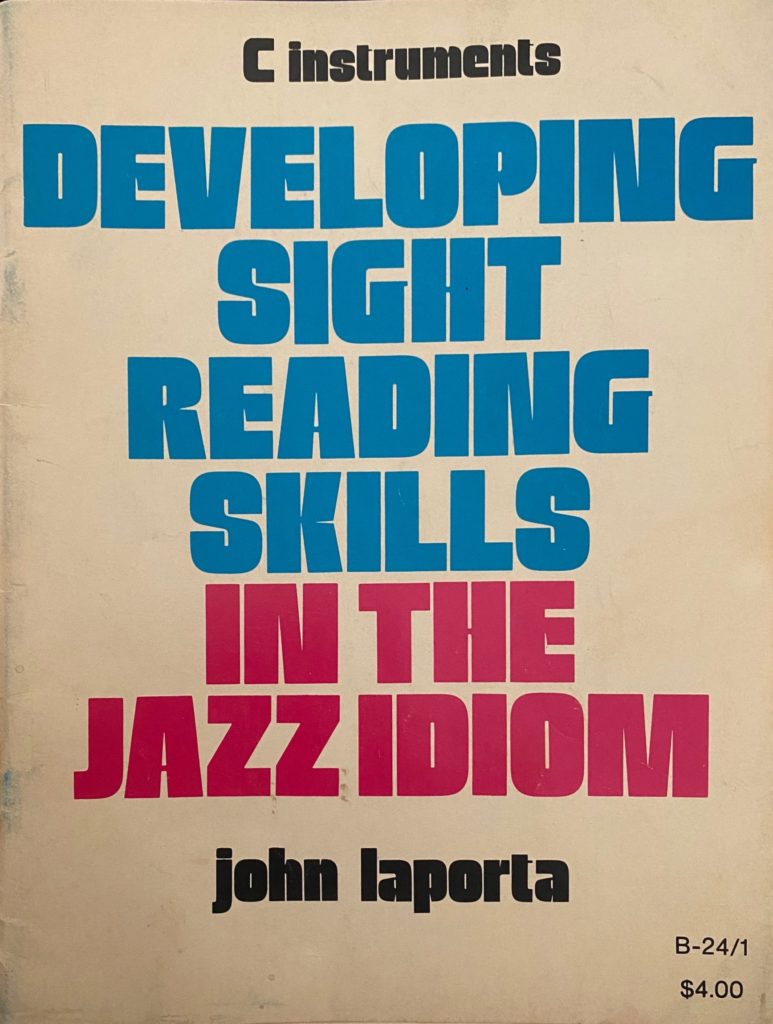
This book by John LaPorta was released by Berklee Press Publications back in 1967. At 26 pages, it’s a small volume but with a big impact and singular focus.
The whole goal is to provide high quality sight reading materials (compositions written as duets in treble clef) that has clear musical goals.
John writes in the introduction:
This programmed method is designed to aid the student in:
1. Improving his ability to read music at sight
2. The development of his musical conception in the stage band idiom.
3. Developing an awareness of solo, duet, and group techniques.
There are 12 compositions that are included in this book built on “one or two musical ideas and/or rhythmic units indigenous to stage band music”.
With a book like this, the true test is how usable is the material. For me, as I followed the instructions and sight read the compositions I definitely had a better feel for the kind of rhythms and phrasing that comes with playing/performing/improvising jazz. Even though the intention is to help improve sight reading, I actually got more ideas on how to improvise stronger jazz lines.
The problem with a lot of of jazz improvisation education materials is that so much of the emphasis is explaining the scale & chord match, or in the pitch content alone.
However, so much of jazz relies in the combination of “how” you play those notes and the rhythms that make up those melodies.
This book for me is helpful to ingrain some of those aspects.
Of course, you could learn this by listening to a lot of jazz & transcribing… but a book like this certainly can help speed up the process.
All in all, after studying and playing jazz over the years, I wish I worked more on books like this when I started learning jazz. It probably would have helped me learn certain aspects of the music much faster. If you can locate a copy of this book, it’s a worthwhile addition to your jazz education library & practice routine. I do wish that Berklee Press reprint John’s other books (besides his excellent book, “A Guide To Jazz Improvisation”, which is still in print and widely available).
Pros: Great compositions for sight reading practice. Good instructions on how to practice the material too.
Cons: It might seem like a slim book, so depending on the price that you get it for, you might feel it’s worth it (or not).
TLDR: If you want to develop your sight reading & jazz phrasing, this is a worthwhile book to get (if you can find a copy).
Where can you buy this book? I recommend checking out Amazon, eBay, Abe Books to see whether they have this book in stock. Please remember that this book comes in versions for C instruments, Bb instruments, Eb instruments and C Bass Instruments, so be aware of that when you purchase a copy.
[Review Archive]
I wrote a lot of other book, course and video reviews too.
Check out the rest here:
[Read more reviews]
[Submissions for Review Consideration]
- Are you an author who wrote a jazz, guitar or music book?
- Have you created a DVD or an online video course or subscription based website?
- Would you like me to review your book/course?
Please send me a message at azsamad3 at gmail.com with:
For courses: a link to the course/video/product + access info etc.
For books: a link to the book (Dropbox) or PDF attachment (if it’s small) for review consideration.
Depending on whether I dig the book/course, I’ll let you know if I do plan to review it!
I cannot guarantee a review for every submission & if I’m not too into it, I may opt not to review it. I mean, it’s better to get a good review that for me to write a bad review just because it’s not a match for the kind of stuff I dig right? :p
NOTE: All reviews reflect my honest personal opinion so be aware that I will point out both cool Pros and Cons that I see in the work. You dig?
Leave a Reply